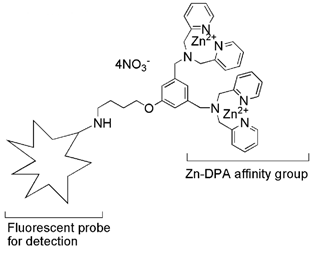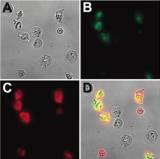For imaging of cell death and bacterial infections
본문
PSVue? for imaging of cell death and bacterial infections
Phosphatidylserine(PS) 검출 probe입니다.

PROPOSED MECHANISM OF BINDING OF PSVue? TO APOPTOTIC MEMBRANES: A TWO-POINT INTERACTION
PSVue?는 bis(zinc2 + dipicolylamine : Zn-DPA)를 포함하는 fluorescent probes 입니다. Zn-DPA는 anionic phospholipids에 높은 친화성을 나타내는 것으로 알려져 있으며, 세포막의 phosphatidylserine(PS)에 결합합니다. apoptotic cells [1], necrotic cells [2], Gram+ and Gram- bacteria [3-5], activated cells, tumor vascular endothelial cells, viruses 등의 검출에 사용할 수 있습니다.
Key Features of PSVue? Probes:
- Bind to a variety of cell types which have negatively charged phospholipids exposed on their membranes including apoptotic cells [1], necrotic cells [2], Gram+ and Gram- bacteria [3-5], activated cells, tumor vascular endothelial cells, viruses, etc.
- Available in a range of detection wavelengths from long-UV to near infrared.
- Suitable for in vitro and in vivo use.
- Suitable for high-throughput screening assays.
- Bind to the same PS site as annexin-V.
Advantages of PSVue? over Fluorescent Annexin-V:
- Binding kinetics are fast; annexin-V binding is slow
- Binding is Ca²+ independent; means no artifacts due to activation of nonspecific membrane scramblases by Ca²+.
- Cheap compared to most annexin-V fluorescent analogs
- Apoptosis can be detected under a wide variety of conditions(e.g. in presence of 10% serum, temps from 4 to 37°C).
- Can provide more intense labeling due to their much smaller size (i.e. >10 PSVueTM molecules can bind to the same area as 1 annexin V molecule).

PMicrographs (60X magnification) of Jurkat cells, treated with cytotoxic camptothecin (10 μM) for 3.5 h and stained simultaneously with Annexin VAlexa Fluor 488, and PSVue? 794 (10 μM). Brightfield image of the entire field of cells (A); cells stained with Annexin V-Alexa Fluor 488 (B); cells stained with PSVue? 794 (C); overlay of images A, B, and C (D). No staining of healthy cells was observed in the absence of camptothecin. (Image courtesy of Dr. Bradley Smith of University of Notre Dame)
|
Catalog No. |
Name |
Description |
|
P-1001 |
PSVue? 794
|
The PSVue?794 (formerly PSS-794) reagent kit contains components to provide ~ 0.68 mL of a 1 mM solution of PSVue794 in aqueous solution. The compound exhibits absorbance and fluorescence excitation maximum at 794 nm and emission maximum at 810 nm. The labeling vehicle provided with the kit (Diluent X) is designed to maximize dye solubility and is suitable for in vitro and in vivo use. |
|
P-1002 |
PSVue? 380
|
The PSVue?380 (formerly PSS-380) reagent kit contains components to provide ~ 0.40 mL of a 2 mM solution of PSVue?380 in 50% aqueous ethanol solution. The compound has an absorbance max at 380nm and a fluorescence emission max at 440nm. |
|
P-1003 |
PSVue? 480
|
The PSVue?480 (formerly PSS-480) reagent kit contains components to provide ~0.5 mL of a 1 mM solution of PSVue?480 in 50% aqueous dimethylsulfoxide solution. The compound has an absorbance max at 480nm and an fluorescence emission max at 519 nm |
|
P-1004 |
PSVue? Biotin
|
Vial contains 1mg of solid. PS?Vue biotin can be complexed with streptavidin-coated quantum dots (not provided) for in vivo and in vitro use. Procedures to formulate PSVue?biotin and prepare the PSVue? biotin-streptavidin -coated quantum dot complex are provided. |
|
P-1005 |
PSVue? 550
|
The PSVue?550 reagent kit contains components to provide ~0.5 mL of a 1 mM solution of PSVue?550. The compound has an absorbance max at 553 nm and an fluorescence emission max at 615 nm |
|
P-1006 |
PSVue? 794
|
The PSVue643 kit contains 0.25mL of a 1mM solution of PSVue643 in water. The compound has an absorbance max at 643nm and a fluorescence emission max at 658nm |
|
P-1007 |
PSVue? 794
|
This probe contains the same fluorophore present in PSVue 794 but without the Zn-DPA targeting moiety attached. The kit contains 0.6mL of a 1 mM solution of 794-control probe in aqueous solution. The compound exhibits absorbance and fluorescence excitation maximum at 787 nm and emission maximum at 808 nm |
* PSVue? is a trademark of Molecular Targeting Technologies, Inc. PSVue? products are sold under an exclusive license from the University of Notre Dame.US Patent # 7,179,616 and others pending.
댓글목록
등록된 댓글이 없습니다.